Description of the Blue Dragon variety
Blue Dragon (pronounced Blue Dragon) was bred by LLG / Sorano in 2005. The standard-sized violet immediately fell in love with collectors for its flowers, the beauty of which cannot be conveyed in the photo. The color of the buds cannot be called simple - semi-double and double stars of light blue color seem to glow from the inside thanks to the dark blue center. A contrasting purple border is located along the edge of the petals, and a fickle light green border often appears.
The foliage of the Blue Dragon is attractive - dark green, with a reddish underside and a jagged edge. The variety builds up a powerful rosette; in adult plants, its diameter can reach 45 centimeters. The plates are juicy, resilient and large. In shape, the rosette resembles a vase - the cuttings rise slightly upward, and then unfold horizontally.
Violet Blue Dragon is a big lover of bloom; in adulthood, it always shows a lush hat, which is located above the rosette. The buds are quite large, reaching 5-7 cm, while on each peduncle their number can vary from 5 to 8 pieces.
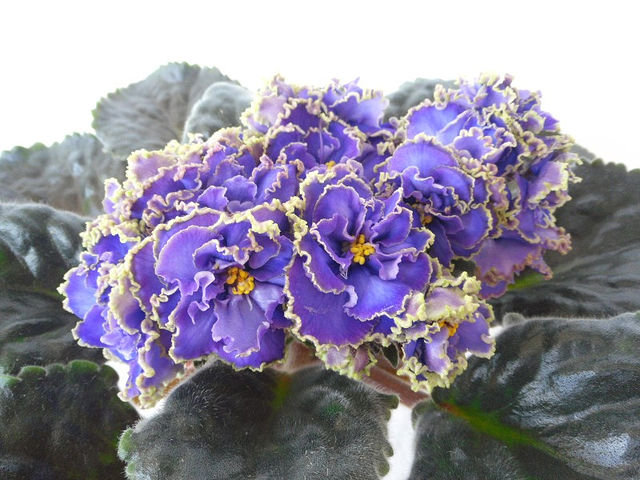
The Blue Dragon does not tolerate heat well - in such conditions, not only does the appearance of the outlet deteriorate, the cuttings grow long and sloppy, but also appear unpainted on the buds. In summer, this violet is best grown on a cool windowsill or placed on the bottom shelf of a shelf.
Since the full potential of the variety is revealed with a powerful outlet, Blue Dragon needs to be heavily fed. Using fertilizer helps the violet grow good roots and leaves. The signs of starvation instantly affect the appearance of the Blue Dragon - the plates lose their rich color and shine, the quality of flowering decreases.
When propagated by a leaf, Blue Dragon most often gives 1-2 children, no more. Growth in young plants is slow, so you have to wait a long time before flowering. The Blue Dragon is sporty, but an inappropriate specimen can be recognized by the foliage - it is always curly.
Violet Blue Dragon loves free space, and in cramped conditions it lifts the leaves up, which is why the rosette loses its harmony. The green border is more pronounced when kept in cool conditions.
Basic rules for home care
It is not difficult to care for the Blue Dragon violet.

The soil in the pot should not dry out, but excess moisture is also not acceptable. Water should not come into contact with the top green part of the plant, as this can cause decay or sunburn. For irrigation, use settled water at room temperature.
In winter, it is recommended to warm it up a little. Water is poured over the edges of the pot. For convenience, use a small watering can with a narrow spout or a douche bulb. You can also make a hole in the lid in a regular plastic bottle and insert a tube into it. Excess water from the pan must be drained.
Many experienced gardeners use bottom watering - they put a pot with a flower in a container with water for 20-30 minutes, the level of which reaches 2/3 of the pot. Wick irrigation is considered the most acceptable. To carry out such watering, a wick from a cord is inserted into the hole in the pot, which is lowered into a container of water. It is very convenient if the owner of violets leaves somewhere for 1-2 weeks. In summer, watering is made more abundant, and in winter, the intensity of watering is reduced.
Fertilization
Top dressing is best done with special liquid fertilizers. Young specimens that grow green mass are more in need of nitrogen. Older Saintpaulias, which are ready to bloom, require feeding with potassium and phosphorus.Liquid fertilizers for flowering houseplants are perfect for fertilizing. They should be used 1-2 times every 30 days.

When using fertilizers, you should adhere to the recommended rates in the instructions. An excess of chemical elements that are contained in the fertilizer can negatively affect the growth and development of the plant.
When planting and transplanting violets into fresh soil, you do not need to fertilize for 2 months. The soil will have enough nutrients for its growth. For top dressing, you can sometimes use such well-known home remedies as black tea, coffee grounds, baker's yeast solution.
You need to prune violets for the following reasons:
- Removing the extra leaves promotes more abundant flowering.
- Trimming the tops of old Saintpaulias rejuvenates the plant. After a while, children grow on the remaining hemp, which are used for reproduction.
- It is necessary to trim leaves affected by various diseases in order to prevent the spread of the disease.

As it grows and develops, old and spoiled leaves, as well as faded flower stalks, should be cut off. If the flower is too overgrown, the side rosettes should be cut off. Removing the leaves is easy. To do this, press with your fingernail at the base and tear off the excess leaves by twisting. They can also be simply cut with sharp scissors. If, after breaking off the lower leaves, the trunk is bare, then a little soil should be poured.
The violet, as it grows, is transplanted into a new pot about 1 time in 2-3 years. The process is carried out when the plant is not blooming. This is usually the month of March. To transplant this indoor flower, the method of transshipment of an earthen coma is used, which allows the root system to be injured as little as possible.
For this purpose, they take a small and shallow pot, since the root system of violets is not particularly developed, and large excess soil can begin to acidify, which will cause the appearance of some fungal diseases. The pot must have a hole for excess moisture to escape. At the bottom, a drainage layer of 3 cm made of expanded clay or pebbles must be placed.

As a soil for planting, nutritious loose soil with an acidity of 6.5-6.7 pH is suitable. Ready-made soil for transplanting can be purchased at a garden store, or you can prepare it yourself. The following mixture is well suited for this purpose - 5 parts of leafy earth, 3 parts of peat and 1 part of river sand.
Charcoal and sphagnum can be added to this mixture. The soil mixture must be disinfected before use in order to avoid the appearance of various fungi and bacteria. To do this, pour boiling water over it or ignite it in the oven (you can use it in the microwave).
On the eve of transplantation, the flower is watered. If a plant has rotted root areas, then they are cut off, and the soil is completely changed. When transplanting, remove the lower and damaged leaves. An overgrown plant is divided into rosettes. The transplant itself is carried out in a sufficiently moist soil and is not very compacted. Then watering is carried out after 2-3 days.
"White Tower"
What are its features? This variety differs from other members of the Compositae family for its excellent decorative properties. The bushes of the white peony aster can reach a height of 50 to 70 centimeters. They are very curvy. The average crown diameter is 40 cm, making the plant well suited for decorative pruning. The buds have a hemispherical or perfectly round shape. As you might guess from the name, they have a pure white color. One bush can have up to 12 shoots, which are densely covered with buds during the flowering period.
The flowering period of the white tower peony aster is intense and long, for which this variety has gained its popularity among many gardeners. It starts in early July and lasts right through to mid-September. The plant is unpretentious in care and cultivation, so its cultivation does not require a lot of physical and time costs. More details about this will be discussed later.
Features of Blue Dragon violet care at home
This variety of Saintpaulia is picky about care and keeping conditions. If the basic rules are not followed, it is unlikely that it will be possible to achieve lush flowering.
Temperature
Saintpaulia of this species prefers cool contents. A favorable temperature for her is 18-22 ° C. It is with this mode that the best decorative qualities of the variety are manifested.
As the temperature rises, the flowers wither, the lilac border on the petals disappears, and the buds become noticeably smaller.
Lighting
Light is very important for this type of violet. Bluedragon needs good lighting. The duration of daylight hours should be 14-16 hours. In the evening, additional lamps should be used.
For lush flowering, the lighting must be uniform.
Over time, the rosette can tilt towards the window, so it is periodically recommended to rotate the flower pot.
Important! With a lack of light, the flowers lose their color, and their general appearance becomes dull
Watering
Such a Saintpaulia does not suffer from a lack of moisture, and is able to develop normally during dry periods. This is one of the advantages of the variety.
Watering is recommended twice a week, and at a low temperature of the content - 1 time in 7-10 days.
Spraying
To increase the humidity, the socket can be sprayed. It is necessary to dissipate moisture in small drops, resembling fog, at a distance of 30-35 cm from the plant
It is important that the water does not get on the flowers, as this will lead to the appearance of brown spots.
Humidity
The blue dragon needs moderate humidity within 60%. If the air is too dry, then additional containers with water are placed near the flower to increase the evaporation area.
Priming
For the full development of a flower, a soil with an increased level of acidity is needed. You can purchase balanced soil from the store or prepare it yourself. To do this, you need to connect:
- sod soil (30%);
- leafy ground (20%);
- sand (15%);
- perlite (10%);
- charcoal (10%);
- peat (15%).
Note! It is important for the Blue Dragon that the soil is well drained.
Top dressing
The blue dragon needs adequate nutrition, but reacts negatively to excess fertilizer in the soil. To feed it, it is necessary to use mineral fertilizers for violets, but the indicated dosage is recommended to be reduced by 2 times.
In the active phase of growth and flowering, the frequency of fertilization is 2-3 times a month. In autumn and winter - 1-2 times every 30 days.
Planting and leaving
When choosing a place to place Halcyon hosts, it should be remembered that this variety feels great in an area with any illumination, the main thing is that there is enough moisture without stagnation. Prefers loose, slightly acidic, air and moisture permeable soils.
When preparing a landing site, you must:
- dig up the soil to the depth of the shovel bayonet;
- fertilize;
- dig a hole with a volume of 2 times the size of the root;
- lay drainage;
- pour a small hill of the prepared substrate on which the root system of the seedling will be located.
A sprout is placed in the prepared hole, spreading the roots along the poured slide. Fall asleep with the remaining soil, making sure that the growth bud is flush with the soil surface. The earth is tamped and watered with settled water.
Further care consists in regular watering, as the plant loves moisture. Watering is carried out early in the morning at the root at least once every 3-4 days, preventing the soil from drying out. Surface watering should be avoided so as not to disturb the decorative effect of the bush and not to dry out the soil, since dense thickets of leaves prevent moisture from reaching the roots of the plant.
The plant of the Khaltsion variety is quite winter-hardy, but in preparation for the winter period, it is required to mulch the bush with covering material
This is especially important for young plants. Well helps to retain moisture mulching the soil around the bush in the spring
It is not worth pruning the plant, the only thing that needs to be removed is the peduncles with faded flowers.
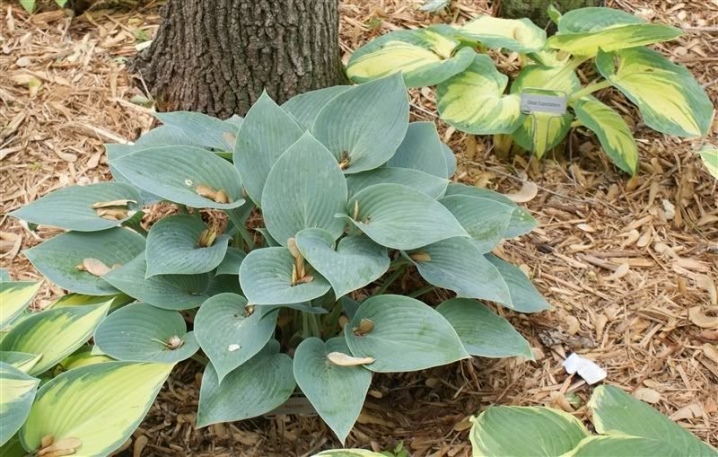
If the hosta is planted in an area with poor soil, it needs fertilizing at least three times per season, but no later than July. For these purposes, you can use any complex fertilizer for garden plants.
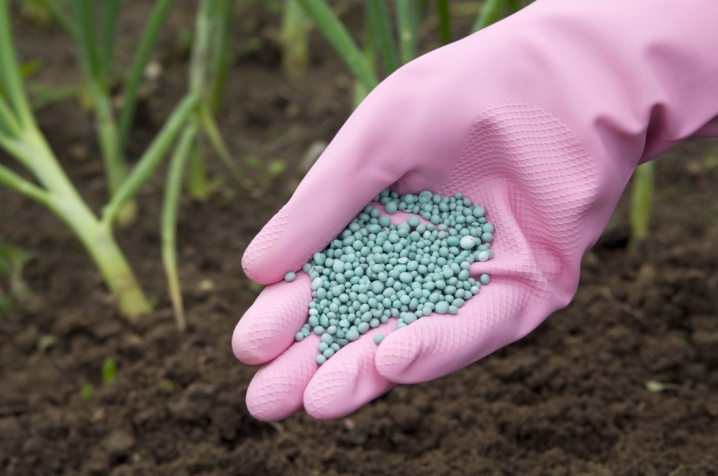
Violet Blue dragon LLG / P. Sorano
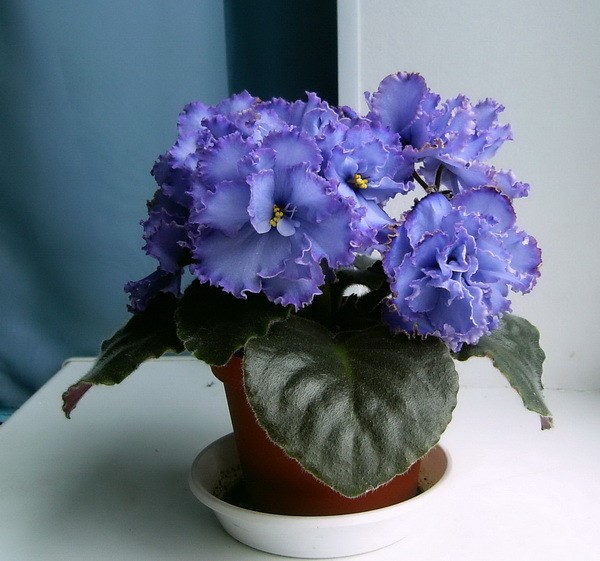
Cute violet Blue Dragon.
Every fan of growing indoor violets simply must have a Blue Dragon in their collection. Many growers think so. And they will tell you the main arguments. One of the first Saintpaulias is not purple in color. Before her, there were only purple coloring. It is prestigious to have such beauty. It has flowers almost flush with the leaves.
What species does it belong to?
These are large-flowered Saintpaulias. Pronounced double star. Sometimes the flowers are semi-double. The dimensions of the socket allow it to be unconditionally ranked among very large standards.
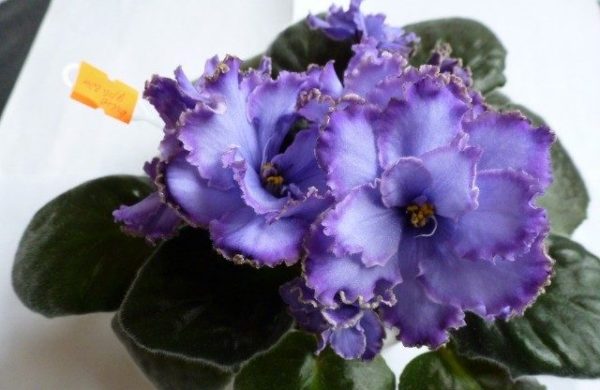
This variety belongs to the terry types.
History of the variety, by whom was it bred?
The surname and name of the creator of the variety can be seen more than one:
- There are statements in the publications that the variety was bred by Lyndon Lyon;
- The greenhouse really is. Lyndon Lyon Greeghouse. It has existed for 60 years. And it has been headed by Paul Sorano since 1993. But Lyndon Lyon is his grandfather;
- Actually. This is a cultivar bred by LLG / P. Sorano. 9516. And it was registered on December 17, 2005;
-
More about this company:
- 6 greenhouses with five employees;
- Bred by the company 800 varieties;
- The first terry violet;
- She's the first blue one.
- Paul Sorano himself prefers red, coral and deep purple colors. Chimeric and fantasy specimens.
The blue dragon in the east is a symbol of wisdom and greatness.
Below are the most famous varieties. Except for the Blue Dragon.
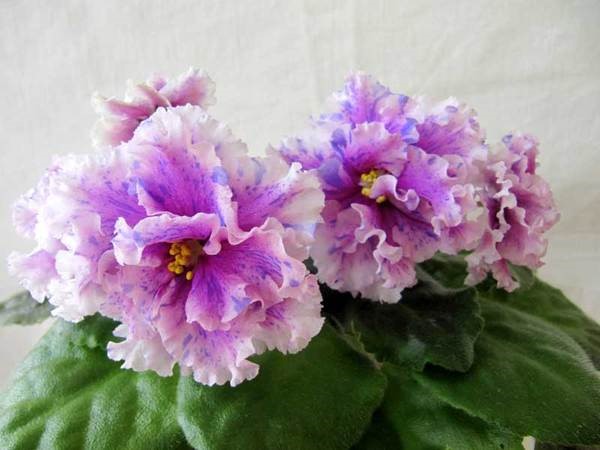
Mysterious violet Bold Party Girl.
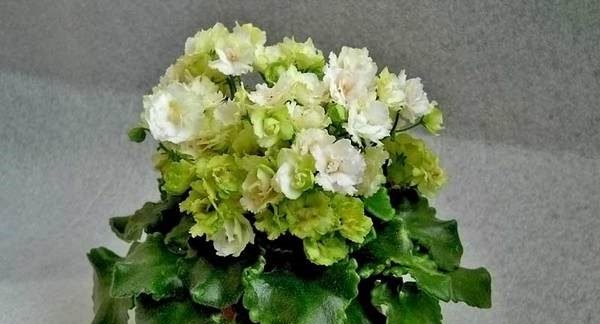
Beautiful violet Irish Flirt.
Saintpaulia Blue Dragon: photo and description
The photo of the violet Blue Dragon is impressive. Even if the quality is not very good. Unless the shades are different. But they can actually be in the plant. Conditions make their own adjustments to the coloring:
Socket. It impresses with its size not only buyers. But also experienced florists. It is 40-45 cm in diameter. But it forms slowly;
Leaves. Dark green top, and reddish bottom
Notches around the edge draw attention. They do not grow very beautifully on long cuttings from the middle.
Oval. They even dodge;
Peduncles. Strong and upright with huge flowers;
Flower. Terry, less often semi-double. Heart-shaped blue petals near the peduncle are darker. With a distinctive ruffled red-purple border. And a green-golden pubescent edge. In most cases, this is 5-7 cm. Florists have shown specimens even up to 9 cm!
Attention! Many experts pay attention to the variability of the color of the variety. The fringe may disappear in heat.


